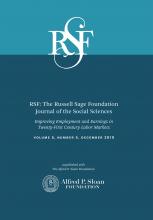Research Article
Open Access
Improving Employment and Earnings in Twenty-First Century Labor Markets: An Introduction
Erica L. Groshen, Harry J. Holzer
RSF: The Russell Sage Foundation Journal of the Social Sciences December 2019, 5 (5) 1-19; DOI: https://doi.org/10.7758/RSF.2019.5.5.01
Erica L. Groshen
aSenior extension faculty at the School of Industrial and Labor Relations, Cornell University
Harry J. Holzer
bJohn LaFarge SJ Professor of Public Policy at the McCourt School of Public Policy, Georgetown University

REFERENCES
- ↵
- Abowd, John, and
- Francis Kramarz
- ↵
- ↵
- Abraham, Katharine G., and
- Melissa Kearney
- ↵
- Acemoglu, Daron, and
- Pascual Restrepo
- ↵
- Andersson, Fredrik,
- Harry J. Holzer, and
- Julia Lane
- ↵
- Austin, Benjamin,
- Edward Glaeser, and Lawrence Summers
- ↵
- Autor, David
- ↵
- Autor, David
- ↵
- ↵
- Autor, David
- ↵
- Autor, David,
- David Dorn,
- Lawrence Katz,
- Christina Patterson, and
- John Van Reenen
- ↵
- Autor, David, and
- Mark Duggan
- ↵
- Autor, David, and
- Lawrence F. Katz
- ↵
- Autor, David,
- Lawrence F. Katz, and
- Melissa Kearney
- ↵
- ↵
- Autor, David, and
- Melanie Wasserman
- ↵
- Baily, Martin, and
- Nicholas Montalbano
- ↵
- Beaudry, Paul,
- David Green, and
- Benjamin Sand
- ↵
- Bernstein, Jared
- ↵
- Black, Sandra,
- Diane Whitmore Schanzenbach, and
- Audrey Breitwieser
- ↵
- Blanchard, Olivier, and
- Lawrence F. Katz
- ↵
- Blasi, Joseph,
- Richard Freeman, and
- Douglas Kruse
- ↵
- ↵
- ↵
- Bound, John, and
- Harry J. Holzer
- ↵
- ↵
- Burtless, Gary, and
- Sveta Milusheva
- Card, David, and
- Jonathan Dinardo
- ↵
- Davis, Steven, and
- Till von Wachter
- ↵
- Doar, Robert,
- Harry J. Holzer, and
- Brent Orrell
- ↵
- ↵
- Farber, Henry
- ↵
- Fortin, Nicole,
- Thomas Lemieux, and
- Neil Lloyd
- ↵
- Freeman, Richard
- ↵
- Freeman, Richard,
- Joni Hersch, and
- Lawrence Mishel
- ↵
- Frey, William
- ↵
- Goldin, Claudia, and
- Lawrence F. Katz
- ↵
- Gould, Elise
- ↵
- Groshen, Erica L.,
- Susan Helper,
- John Paul MacDuffie, and
- Charles Carson
- ↵
- Harris, Seth, and
- Alan Krueger
- ↵
- Holzer, Harry J.
- ↵
- Holzer, Harry J.
- ↵
- Holzer, Harry J., and
- Marek Hlavac
- ↵
- Holzer, Harry J.,
- Steven Raphael, and
- Michael A. Stoll
- ↵
- Judy, Richard, and
- Carol D’Amico
- ↵
- Katz, Lawrence F., and
- Alan B. Krueger
- ↵
- ↵
- Katz, Lawrence F.,
- Ai-jen Poo, and
- Elaine Waxman
- ↵
- Kelley, Maryellen, and
- Susan Helper
- ↵
- ↵
- Krueger, Alan
- ↵
- Kugler, Adriana
- ↵
- Levy, Frank
- ↵
- Levy, Frank, and
- Richard Murnane
- ↵
- ↵
- ↵
- Mandel, Michael
- ↵
- Neal, Derek
- ↵
- Nedelkoska, Ljubica, and
- Glenda Quintini
- ↵
- Organization for Economic Cooperation and Development (OECD)
- ↵
- Osterman, Paul
- ↵
- Pierce, Brooks
- ↵
- ↵
- Schmitt, John,
- Heidi Shierholz, and
- Lawrence Mishel
- ↵
- Shambaugh, Jay,
- Audrey Breitwieser, and
- Patrick Liu
- ↵
- Shambaugh, Jay,
- Ryan Nunn,
- Patrick Liu, and
- Greg Nantz
- ↵
- Shimada, Haruo, and
- John Paul MacDuffie
- ↵
- Stansbury, Anna, and Lawrence Summers
- ↵
- Ton, Zeynep
- ↵
- U.S. Bureau of Labor Statistics (BLS)
- ↵
- U.S. Census Bureau
- ↵
- U.S. Census Bureau
- ↵
- Van Horn, Carl,
- Tammy Edwards, and
- Todd Greene
- ↵
- Weil, David
- ↵
- ↵
- West, Darrell
In this issue
Improving Employment and Earnings in Twenty-First Century Labor Markets: An Introduction
Erica L. Groshen, Harry J. Holzer
RSF: The Russell Sage Foundation Journal of the Social Sciences Dec 2019, 5 (5) 1-19; DOI: 10.7758/RSF.2019.5.5.01
Jump to section
Related Articles
- No related articles found.
Cited By...
- No citing articles found.





